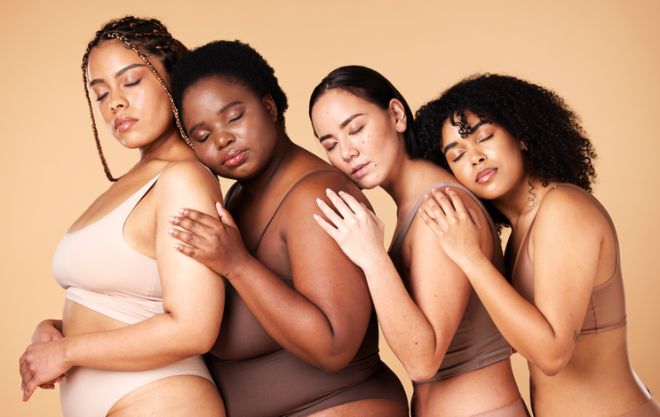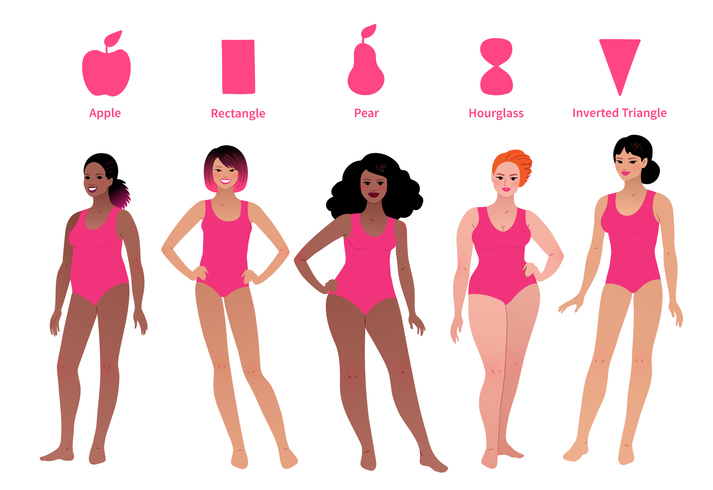What Does Your Body Type Say About Your Overall Health?
Curves, Slim-Thick, Or Athletic—What Your Body Shape Really Says About Your Health
Share the post
Share this link via
Or copy link

Are you having trouble getting rid of that stubborn fat from around your belly or having difficulty putting on more weight to increase muscle mass? Women come in so many shapes and sizes and our body type can truly determine how we lose weight or offer clues about our general health as a whole.
Dr. Fatima Cody Stanford and Dr. Lydia C. Alexander, president of the Obesity Medicine Association, sat down for an in depth interview with TODAY on Jan. 30 to discuss some of the common body types women have and what it may determine about the way your body processes fat, impacting your weight. Alexander explained that hormones such as estrogen and genetics play a key role in how fat is distributed in the body. However, an unhealthy diet and lack of physical activity can disrupt these natural factors, negatively affecting metabolic health if we don’t nourish our bodies properly and give them what they need, Alexander noted.
RELATED CONTENT: How Lori Harvey Used The Modeling Industry’s ‘Pressure To Be A Certain Size’ To Fight For Inclusivity
Love MadameNoire? Get more! Join the MadameNoire Newsletter
We care about your data. See our privacy policy.
Here is what your body type maybe saying about your overall health and what you can do to make changes to live a healthier and longer life.

Apple Shape

Often referred to as the “apple,” “oval,” or “round” body type, this shape is characterized by a narrower upper body and hips with a wider waist. People with an apple body type tend to carry extra weight around the midsection.
While it’s possible to maintain a healthy weight with an apple-shaped body, Alexander cautions that women with this body type should be mindful of their health. Apple shapes often carry more visceral fat—fat that surrounds the organs in the abdomen, putting them at a higher risk for metabolic issues like heart disease, stroke, and high blood pressure. Fortunately, there are ways to monitor the amount of visceral fat you have. Measurements such as waist circumference, waist-to-hip ratio, and waist-to-height ratio can offer insights into fat distribution.
Stanford adds that your waist size is a key indicator of potential health risks. By measuring your waist in relation to your upper and lower body and observing where you tend to store fat, you can assess if you’re at a higher risk for health complications. To get a more accurate picture, measure your waist circumference at the level of your belly button. According to Stanford, waist circumference is a more reliable measure of obesity-related health risks than the Body Mass Index (BMI), which is based solely on height and weight.
“It doesn’t require any fancy equipment. Just use a simple tape measure that costs $2-3,” Stanford told TODAY. “Women should shoot for a waist circumference of under 35 inches and 40 inches for men.”
Pear Shape

Known as the “triangle” or “spoon” body shape, individuals with a pear shape have narrower shoulders and busts, with fuller hips and thighs. Fat tends to accumulate in the lower body, specifically the hips and thighs. While storing fat in this area is less metabolically risky than around the waist, it doesn’t automatically make someone with this body type healthier.
That’s why maintaining a healthy body composition, which refers to the percentage of fat, bone, and muscle in your body, is key, Web MD notes. To support your health, people with a pear-shaped body should focus on eating healthy by consuming a balanced diet of whole foods like lean proteins, fruits, vegetables, and whole grains. Incorporate regular cardio exercises, such as running or cycling, and strength training, especially lower-body exercises like squats and lunges, to target the hips and thighs. High-intensity interval training (HIIT) can also boost fat loss.
Hourglass Shape

Women with an hourglass figure feature shoulders and hips that are roughly the same width, with a noticeably smaller waist. Weight tends to distribute evenly across the arms, bust, hips, and thighs. Some women may be classified as a “top hourglass” or “bottom hourglass” depending on whether their bust or hips are slightly larger, while still having a defined waist.
Women with this unique shape can focus on exercises that enhance their natural curves by toning both the upper and lower body. Strength training moves like squats, lunges, and glute bridges can help define the hips and thighs, while upper body exercises such as push-ups, dumbbell presses, and rows can maintain or build shoulder and arm strength. Incorporating core exercises like planks and Russian twists can help keep the waistline defined.
Inverted Triangle Shape

Those with an inverted triangle shape often carry more weight in their upper body, especially around the bust, while their stomach and hips remain narrower. Women with this body type may experience back pain due to larger breasts, and some may consider breast reduction surgery.
Women with an inverted triangle shape can benefit from exercises that help balance their proportions. Focusing on lower body workouts like squats, lunges, glute bridges, leg presses, and step-ups, which can help build muscle and shape the hips and thighs. Core exercises like bicycle crunches and mountain climbers can tone the midsection while promoting overall stability. Cardio activities like running, cycling, or swimming are great for fat burning and toning the lower body.
Rectangle Shape

Rectangle-shaped women typically have similar measurements across their upper body, waist, and hips, creating a straighter silhouette. While they might have fewer curves, they can still be susceptible to accumulating visceral fat. Exercises targeting the stomach area may be helpful to reduce fat buildup in the abdomen for those with this body type.
Diamond Shape

A less common shape, the diamond body type is marked by a narrow bust, fuller waist, and weight in the hips and upper thighs. Similar to the apple shape, the diamond body stores weight in the upper body and midsection, but the apple shape tends to accumulate more weight in the belly area.
Concentrate on maintaining a healthy diet while targeting your midsection and upper body with strength training and core exercises. Challenge your core by incorporating kettlebell curls or sit-ups into your routine.
Can You Alter Your Body Type?
Your body shape is largely determined by genetics and remains relatively constant throughout your life, according Alexander and Stanford. Even if you lose weight, your body shape will still reflect your natural type. However, as women age and enter perimenopause, some may notice an increase in weight around the waist, even if they didn’t carry weight there before. This change can affect women of all body types, including those with hourglass figures. If you’ve gained visceral fat, lifestyle adjustments may help reduce it over time. Alexander said consistent exercise, a balanced diet, and stress management are essential for maintaining a healthy body over time, and with dedication, you’ll start to notice the positive changes.
What body type are you? Tell us down in the comments.
RELATED CONTENT: Queen Latifah Launches New Initiative To Promote Obesity Care & Fight Weight Stigma
-

My Husband And I Attempted To Have A Creative Date Night At Home -Without A Babysitter - Here's How It Went
-

She Tried It: Ivy Park Drip 2 and 2.2 Black Pack
-

Vontélle Eyewear Founders Score History-Making Licensing Deal With Paramount
-

Our Health, Our Power: Debunking Myths And Taking Charge This Open Enrollment



